Data extracted in September 2024.
Planned article update: October 2025.
Highlights
‘Metal ores and other mining and quarrying products; peat; uranium and thorium’ was the product group with the highest share in tonnes transported by road in the EU in 2023 (23.9%).
‘Food products, beverages and tobacco’ was the product group with the highest share in tonne-kilometres transported by road in the EU in 2023 (16.7%).
‘Flammable liquids’ had the highest share in EU transport of dangerous goods in 2023, with 48.0%.
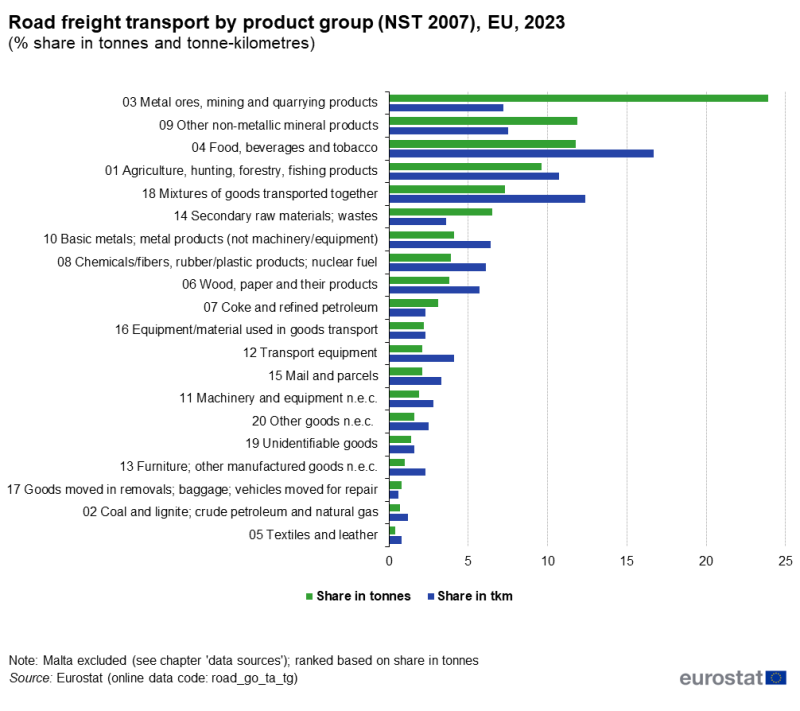
(% share in tonnes and tonne-kilometres)
Source: Eurostat (road_go_ta_tg)
Full names and description of NST 2007 codes
This article presents road freight transport in the European Union (EU), with a focus on the various types of goods transported. It examines the total national and international road freight transport performed, classified by the type of goods. It also provides information on the transport of dangerous goods. Finally, it offers an overview of road freight transport categorised by cargo type.
This article and the articles 'Road freight transport statistics', 'Road freight transport by vehicle characteristics', 'Road freight transport by journey characteristics' and 'Road freight transport statistics – cabotage' present a complete overview of road freight transport in Europe.
Road freight transport by product good (NST 2007 classification)
Tables 1a and 1b present road freight transport by product group, measured in tonnes and tonne-kilometres (tkm), respectively, over the period 2019-2023.
In terms of tonnes of freight carried, EU road transport declined by 3.4% in 2023 compared with 2022. The number of tonnes carried registered a negative average annual growth rate of 0.8% in the period 2019-2023. In 2023, the product group 03 'metal ores and other mining and quarrying products; peat; uranium and thorium' was the largest product group transported in terms of tonnage, accounting for 3 142.2 million tonnes; its share in the total EU tonnes transported was 23.9% (see Table 1a and Figure 1). This was followed by product group 09 'other non-metallic mineral products' (1 561.3 million tonnes and a share of 11.9%) and product group 04 'food products, beverages and tobacco' (1 550.8 million tonnes and a share of 11.8%). Another major product group was 01 'products of agriculture, hunting, and forestry; fish and other fishing products', accounting for 1 267.4 million tonnes and a share of 9.6%.
From 2022 to 2023, the tonnage carried by road decreased for 13 product groups. The highest declines were observed in groups 09 ‘other non-metallic mineral products’ (-11.2%) and 20 ‘other goods n.e.c.’ (-6.6%). The highest increases were observed in groups 12 ‘transport equipment’ (+12.4%), 13 ‘furniture; other manufactured goods n.e.c.’ (+9.7%) and 02 ‘coal and lignite; crude petroleum and natural gas’ (+7.7%) – n.e.c. stands for ‘not elsewhere classified’.
In terms of average annual growth rate in the period 2019-2023, product group 15 ‘mail, parcels’ recorded the highest growth, at 5.6%, followed by group 18 ‘grouped goods: a mixture of types of goods which are transported together’ and group 20 ‘other goods n.e.c.’ (+3.6% each). The highest negative average annual growth rates were recorded by groups 02 ‘coal and lignite’ and 05 ‘textiles and textile products; leather and leather products’ (-3.0% each).
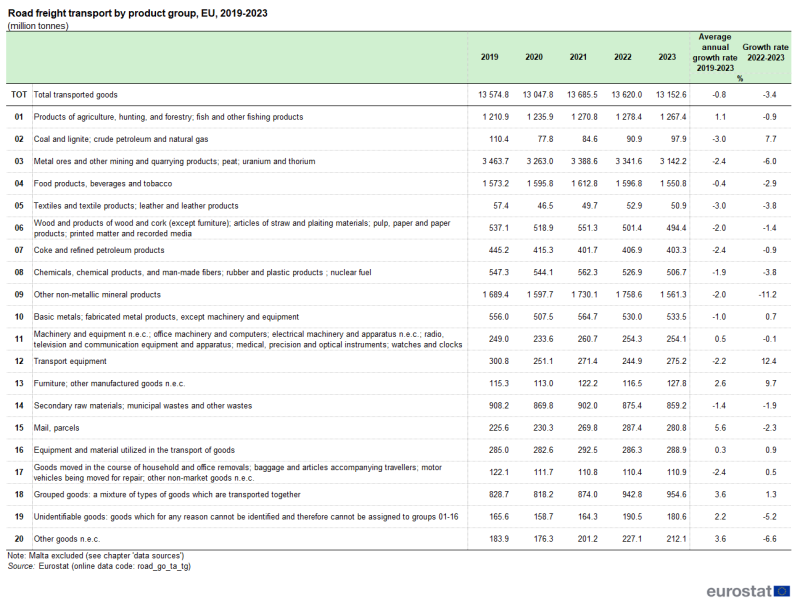
(million tonnes)
Source: Eurostat (road_go_ta_tg)
When looking at road freight transport performance in tonne-kilometres, in 2023 the total EU performance was 3.2% lower than in 2022. The leading goods category was product group 04 ‘food products, beverages and tobacco', accounting for 308.4 billion tkm; its share in the total EU tkm was 16.7% (see Table 1b and Figure 1). This was followed by product groups 18 'grouped goods' (230.3 billion tkm and a share of 12.4%) and 01 'products of agriculture, hunting, and forestry; fish and other fishing products' (197.8 billion tkm and a share of 10.7%). Another product group that recorded significant transport performance was 09 ‘other non-metallic mineral products’, with 138.0 billion tkm and a share of 7.5%.
The largest increases in terms of tkm from 2022 to 2023 were recorded for product group 02 ‘coal and lignite; crude petroleum and natural gas’ (+105.4%, although the values in tkm are rather small), followed by groups 12 ‘transport equipment’ (+8.7%) and 13 ‘furniture; other manufactured goods n.e.c.’ (+8.1%). At the other end of the scale, the highest decreases were recorded for product groups 20 ‘other goods n.e.c.‘ (-15.9%) and 09 ‘other non-metallic mineral products ‘ (-13.3%), followed by group 08 ‘chemicals, chemical products, and man-made fibers; rubber and plastic products ; nuclear fuel’ (-8.3%).
The highest positive average annual growth rates in the period 2019-2023 were recorded for product group 02 ‘coal and lignite; crude petroleum and natural gas’ (+23.2%), followed by groups 19 ‘unidentifiable goods’ (+5.9%) and 13 ‘furniture; other manufactured goods n.e.c.’ with 5.4%. The highest negative average annual growth rates were recorded for groups 08 ‘chemicals, chemical products, and man-made fibers; rubber and plastic products; nuclear fuel’ (-2.8%) and 05 ‘textiles and textile products; leather and leather products’ (-1.9%).
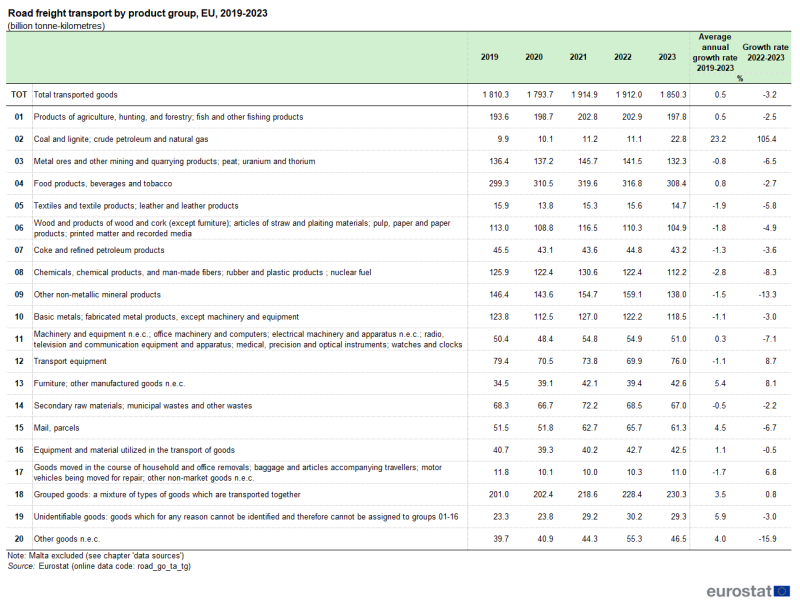
(billion tonne-kilometres)
Source: Eurostat (road_go_ta_tg)

(% share in tonnes and tonne-kilometres)
Source: Eurostat (road_go_ta_tg)
Full names and description of NST 2007 codes
Figure 2 shows the tonne-kilometre share of each NST 2007 product group in the EU total for national and international road freight transport. In 2023, the following groups had a higher share in national transport than in international transport: 01 ' agriculture, hunting, forestry, fishing products', 03 ‘metal ores, mining and quarrying products’, 04 'food, beverages and tobacco', 07 ’coke and refined petroleum products’, 09 ‘other non-metallic mineral products’, 14 'secondary raw materials; wastes', 15 ‘mail and parcels’, and 17 ‘goods moved in removals; baggage; vehicles moved for repair’. For the remaining groups, their share for international road freight transport was higher than for national transport.
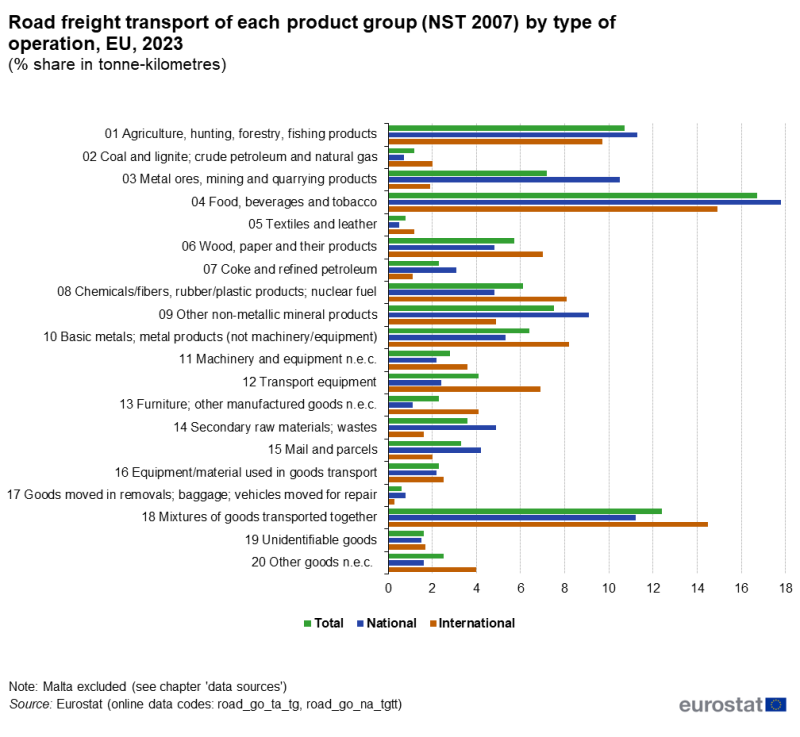
(% share in tonne-kilometres)
Source: Eurostat (road_go_ta_tg), (road_go_na_tgtt)
Full names and description of NST 2007 codes
Road freight transport of dangerous goods
Figure 3 presents the share of dangerous goods in the total transport performance (in tkm) of each EU country in 2022 and 2023. At EU level, the share of dangerous goods transport was 3.5% in 2022 and 3.4% in 2023. The EU countries that recorded the highest shares of dangerous goods in their road transport were Finland (with 10.5% in 2022 and 7.3% in 2023) and Cyprus (with 9.7 in 2022 and 7.0% in 2023), followed by Belgium (with 7.7% in 2022 and 7.0% in 2023). In both 2022 and 2023, several EU countries recorded figures between 4.0% and 6.0%, including the big countries France and Spain. Germany, a big country in terms or road freight transport, recorded shares of 3.9% in 2022 and 4.2% in 2023, while Poland recorded shares of 2.0% in 2022 and 2.6% in 2023. Slovakia, Lithuania and Ireland recorded shares of dangerous goods transport performance of less than 2.0% for both years where data is available. High differences between the two years can be seen for Luxembourg, which increased its share of dangerous goods in total tkm transported from 2.7% in 2022 to 4.9% in 2023.
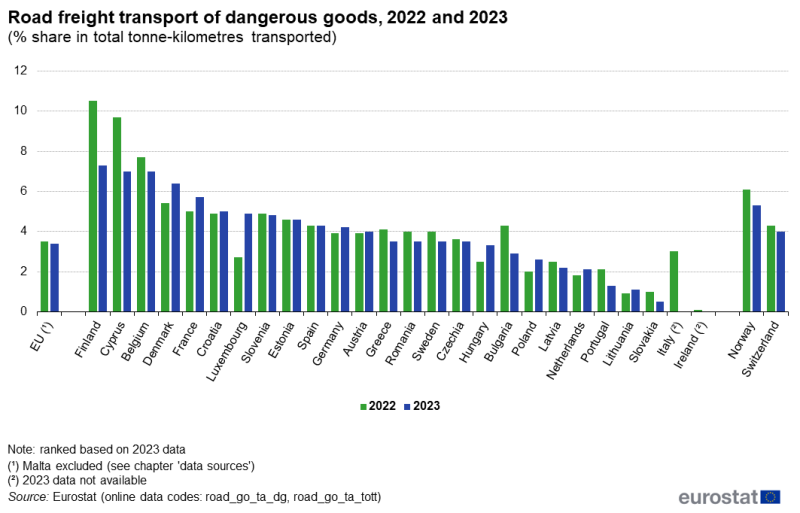
(% share in total tonne-kilometres transported)
Source: Eurostat (road_go_ta_dg), (road_go_ta_tott)
EU transport of dangerous goods accounted for 63 496 million tkm in 2023 (see Table 2) and presented a negative average annual growth rate of 3.6% in the period 2019-2023.
Between 2019 and 2023, 15 EU countries registered a negative average annual growth rate in the transport of dangerous goods. The highest negative rates were recorded for Slovakia (-20.3%), Portugal (-17.2%) and Belgium (-11.1%). At the other end of the scale, the highest positive average annual growth rates were registered in Bulgaria (+41.7%), Denmark (+9.5%) and Czechia (+9.2%).
When looking at the changes between 2022 and 2023, the growth rate in the transport of dangerous goods in the EU decreased by 5.9%. Fifteen EU countries registered decreases in the transport of dangerous goods, the highest ones in Slovakia (-59.7%), Portugal (-47.3%), Finland (-36.2%) and Bulgaria (-36.1%). Substantial increases were observed in Luxembourg (+71.4%), Lithuania (+41.4%) and Poland (+29.9%).
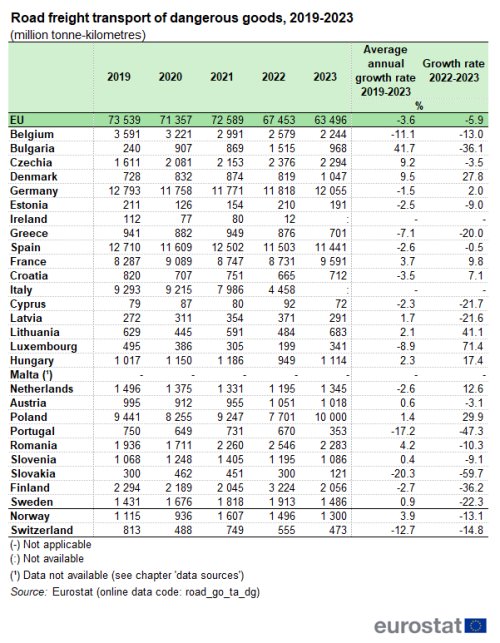
(million tonne-kilometres)
Source: Eurostat (road_go_ta_dg)
Figure 4 illustrates the share of national and international transport performance (in tonnes-kilometres) involving dangerous goods in 2023. At EU level, 73.2% of the transport of dangerous goods was performed within the national borders.
For most countries, in 2023, the share of tkm performed in international transport involving dangerous goods is aligned with the share in tkm of international transport for all types of goods (see article 'Road freight transport by journey characteristics', Figure 2). This means that, in general, countries with high shares in tkm of international transport of all types of goods tend to have a higher share of tkm performance in international transport involving dangerous goods. Notable exceptions are Bulgaria, Czechia, Estonia, Hungary, Portugal and Romania: although international transport of all types of goods represented more than half of the road transport of these countries, most of their transport of dangerous goods was performed in national territory.
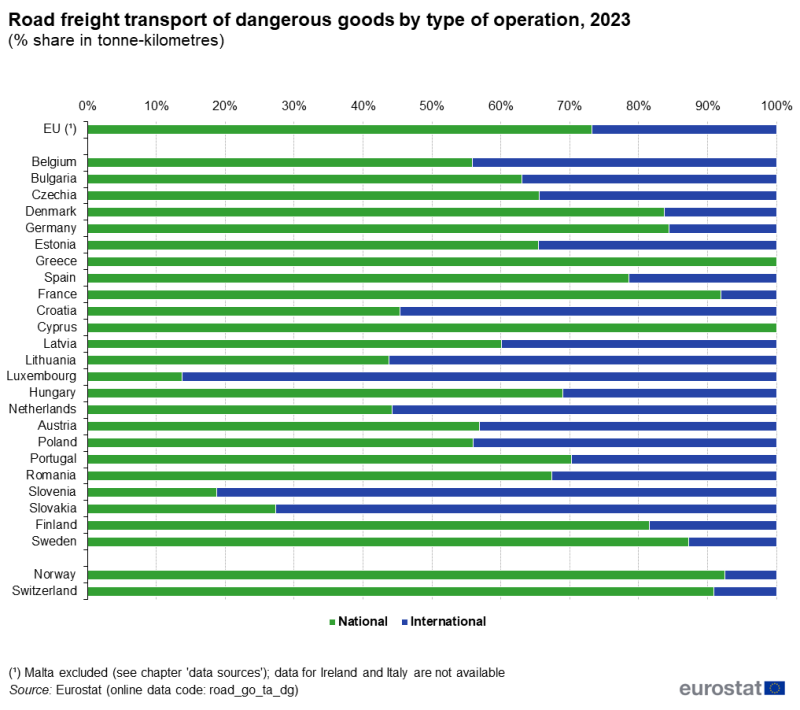
(% share in tonne-kilometres)
Source: Eurostat (road_go_ta_dg)
Figure 5 shows the shares of the different types of dangerous goods in the tkm performed involving dangerous goods in the EU, in 2023. The largest group was ‘flammable liquids’, accounting for nearly half of the transport of dangerous goods (48.0%). ‘Gases, compressed, liquified, dissolved under pressure’ accounted for 15.8%, while ‘corrosives’ accounted for 12.4%. These three types of dangerous goods accounted for over three-quarters (76.2%) of the total tkm performed involving dangerous goods.
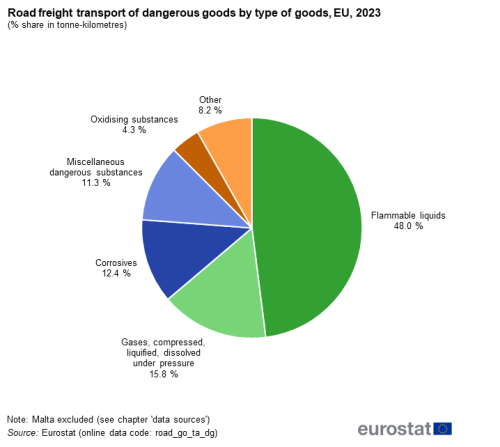
(% share in tonne-kilometres)
Source: Eurostat (road_go_ta_dg)
It should be noted that, as dangerous goods represent only a small proportion of the freight transported by road, there are considerable uncertainties in the survey results regarding this category of goods.
Road freight transport by type of cargo
In 2023, ’palletised goods’ (i.e., goods transported on pallets), represented the main type of cargo in most of the EU countries (see Table 3). The only exception was Cyprus, for which ’solid bulk goods’ represented the main type of cargo.
The EU countries with the highest shares of ’palletised goods’ were Lithuania (72.5%), Romania (71.5%) and Portugal (64.4%), while Cyprus (9.3%), Finland (27.3%) and Austria (33.2%) had the lowest shares.
When looking at the sum of ’palletised goods’ and ’solid bulk goods’, the only countries with an accumulated share below 50 % were Finland (44.5%) and Cyprus (46.5%).
As road freight transport by type of cargo is an optional variable of the road freight transport survey, Ireland and Italy did not report it, while Denmark reported all data as ‘unknown’.
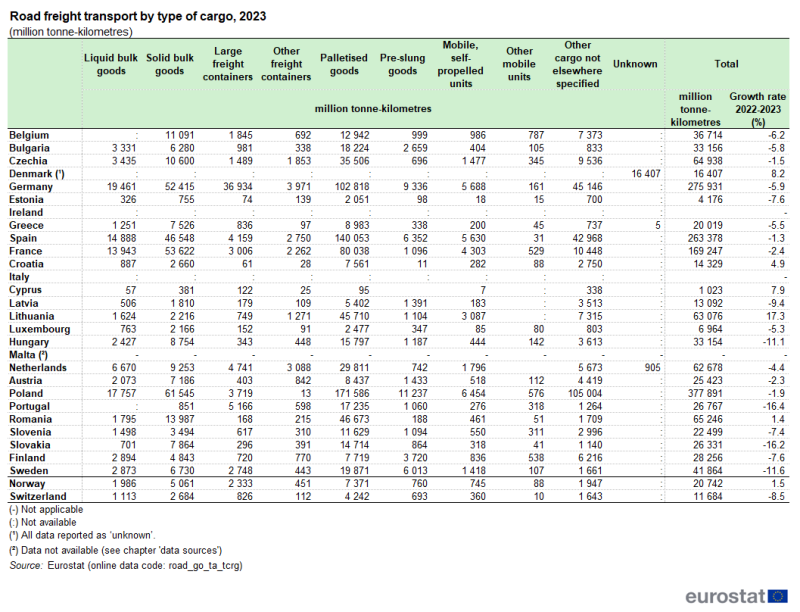
(million tonne-kilometres)
Source: Eurostat (road_go_ta_tcrg)
Source data for tables and graphs
<datadetails> <context>
Context
Data presented in this publication were collected in the framework of Regulation (EU) No 70/2012 on statistical returns in respect of the carriage of goods by road (recast). These data are based on sample surveys carried out in the reporting countries, i.e., the EU countries, Norway and Switzerland, and record the freight transport undertaken by road vehicles registered in these countries.
Reporting countries use their own national surveys for the collection of data, based on returns from road hauliers. The results are microdata referring to vehicles and their linked journeys, providing detailed information on goods transported. At the European level, common aggregation procedures that might diverge from national practices have been used. Differences might therefore occur between the figures in this publication and national values. </context>
Country specific notes
Croatia: While Croatia had no obligation prior to their accession in 2013, it started to report data from the reference year 2008.
Malta: Regulation (EU) No 70/2012 does not apply to Malta, as long as the number of Maltese-registered goods road transport vehicles licensed to engage in international transport does not exceed 400 vehicles.
Finland: National and international surveys have been harmonised and follow a common methodology from Q1 2011 onwards, leading to a break in time series in 2011.
Sweden: A break in series occurred in 2014 following a change in methodology. On the basis of a specific survey, Sweden corrected the European road freight survey results for trucks participating in the sample which were not in use over the surveyed period.
Methodological notes
EU totals calculated in this publication refer to road freight transport reported by the EU countries, excluding Malta which is exempt from reporting road freight statistics.
Total international transport
Total international transport includes international transport loaded, unloaded, cross-trade and cabotage.
Breakdown by goods groups
Starting with the reference year 2008, Regulation (EC) No 1304/2007 establishes NST 2007 as the sole classification for goods carried in road freight transport. For detailed information on the NST 2007 classification, please refer to ‘Classifications’, in Eurostat’s web pages about metadata.
Dangerous goods
Regulation (EU) No 70/2012 stipulates the collection of information on different categories of dangerous goods on an obligatory basis. Annex V of the Regulation (EU) No 70/2012 provides the categories to be used. As the carriage of dangerous goods by road represents only a small percentage of total road transport and the data are collected on the basis of sample surveys, the margins of error in any statistics will be substantial. Any figures for the transport of dangerous goods should be treated with caution.
Type of cargo is the appearance of the cargo unit on presentation for transportation. The provision of data according to the type of cargo is optional in the legal basis. As not all EU countries provide this optional variable, the EU aggregate is not calculated.
Tonne-kilometre (tkm): Unit of measure of goods transport that represents the transport of one tonne by road over one kilometre. The distance taken into account is the distance actually run. It excludes the distance covered when the goods road vehicle is being transported by another means of transport. </datadetails>
Explore further
Other articles
Database
Thematic section
Publications
- Key figures on European transport — 2023 edition - Key figures
- Eurostat regional yearbook — 2023 edition - Flagship publications
- Key figures on Europe – 2023 edition - Key figures
Selected datasets
Methodology
- Road freight transport measurement (ESMS metadata file)
- Glossary for transport statistics — 5th edition — 2019 — Manuals and guidelines
- Methodologies used in road freight transport surveys in Member States, EFTA and 3 candidate countries — 2023 edition - Manuals and guidelines
- Road freight transport methodology — Revised edition, August 2017 - Manuals and guidelines
Legislation
- Regulation (EC) No 70/2012 on statistical returns in respect of the carriage of goods by road (recast)
- Regulation (EU) No 1304/2007 of 7 November 2007 amending Directive 95/64, Regulation (EC) No 1172/98, Regulations (EC) No 91/2003 and (EC) No 1365/2006 with respect to the establishment of NST 2007 as the unique classification for transported goods in certain transport modes
- Commission Regulation (EC) No 202/2010 amending Regulation (EC) No 6/2003 concerning the dissemination of statistics on the carriage of goods by road
